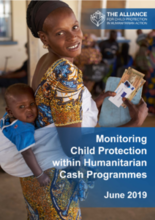Introduction
This paper summarises findings from an initial scoping study, which seeks to review how child protection outcomes are captured when monitoring multi-purpose humanitarian cash programmes. The study intends to inform the development and piloting of new approaches to integrating child protection concerns into multi-purpose cash monitoring frameworks. It was conducted for the Alliance for Child Protection’s, Cash Transfer and Child Protection Task Force.
As the Women’s Refugee Commission (WRC [WRC, 2018]) points out, humanitarian crises are often dangerous contexts that put people at risk. Humanitarian cash programming, as with any other modality, has obligations to monitor and adapt interventions to meet specific needs of diverse groups, and ensure their safety, dignity and inclusion. Therefore, monitoring humanitarian cash needs to capture data relating to protection risks, which includes child protection, so that cash actors can minimize risks and maximise child protection benefits.
By mainstreaming child protection concerns into humanitarian cash throughout the programme cycle and by utilizing cash within child protection approaches such as case management, cash can be optimized as a tool to enhance the protection of crisis affected populations. As WRC (2018) argues, cash is not inherently risky, but simply designing a humanitarian cash intervention without weighing the child protection risks and benefits associated with cash and ensuring mitigation mechanisms, can lead to unintended consequences.
Humanitarian cash that has the objective of meeting basic needs (sometimes called multipurpose cash [MPC]) is challenging to monitor because there are possible outcomes across protection, child protection and multiple technical sectors (food security and nutrition, livelihoods, WASH, shelter, health and education). Any monitoring tool risks becoming too unwieldy if each sector includes all of the indicators that it would like to include.
There is therefore a need for disciplined narrowness in terms of the numbers and types of questions asked by each focus area, including child protection. A plausible theory of change between cash and the outcome or issue being monitored is also necessary. There is a process going on (within the Grand Bargain workstreams) of agreeing MPC outcome indicators. Whilst some initial child protection related indicators were proposed, the process of agreeing on child protection indicators has been shelved until the piloting process started in this paper is completed.
Methods
For this scoping study, a review of the literature on cash and child protection was carried out drawing from recent review of evidence gaps (Sarrouh 2019; Cross et al., 2018). Interviews were conducted with 25 global and country-based stakeholders from NGO’s, UN agencies and donor governments. The study focused on Lebanon, Turkey, Jordan and Somalia where largescale multi-purpose cash programmes are being implemented.
The paper proposes a theory of change of the possible links between cash and child protection to inform the development of a monitoring strategy, including hypotheses that humanitarian cash might contribute to prevention of family separation, reduction of family violence, and supporting foster and temporary caregivers to care for separated and unaccompanied children. The paper concludes with recommendations for approaches to further mainstream child protection concerns into humanitarian cash programming, including tweaking the livelihoods strategy coping index to include questions on separated children and more.

